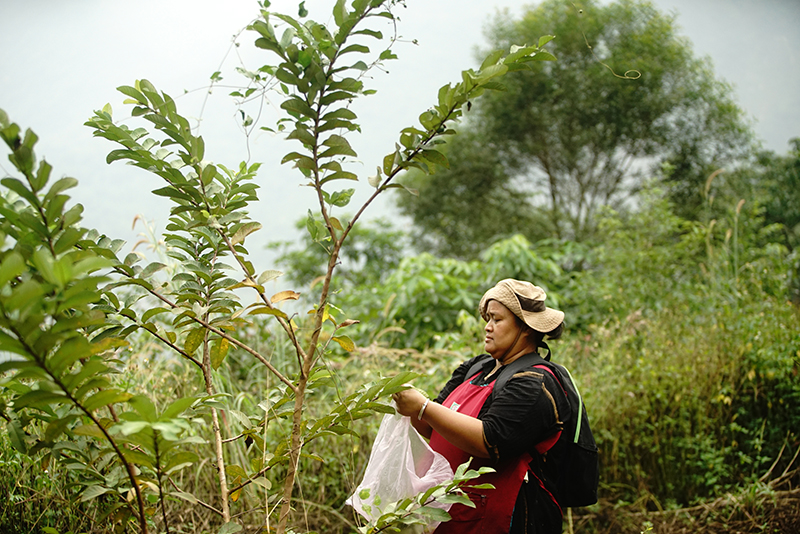
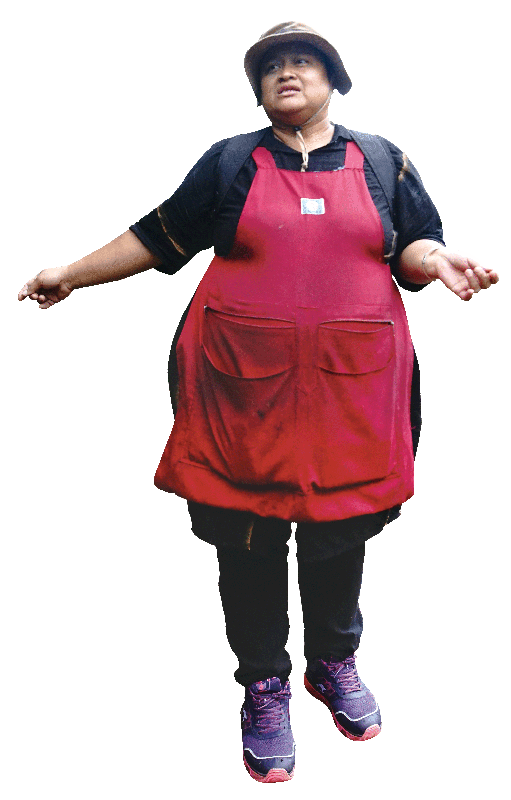
“As a mother, I simply want to help my fellow people find their way home. Only when people are back will our language and culture be able to be passed on.”
Having been engaged in tree planting with her husband, Sula Sukinadrimi, for twenty years, Dresedrese Pacengelaw hopes to recreate a lush piece of forest land for their next generation to grow up carefree and happy as the older generation did. By doing so, she has also found a way home through “replanting” herself in the soil of the homeland.
Dresedrese’s busy day begins in the early morning before the sun rises. By four o’clock, she is up and gets ready for a day’s work: She opens her breakfast restaurant at six, then wakes her kids up at seven, getting them ready for school. After that, she goes back to work at the restaurant until the late morning. At noon, after closing up shop, she follows her husband to their nursery in the community to work non-stop on another “job.”
In the nursery, seedlings of various kinds of native trees, such as Chinese sweetgum (Liquidambar formosanum), glaucous oak (Cyclobalanopsis glauca), Taiwan zelkova (Zelkova serrata), and Chinese Pistache (Pistacia chinensis Bunge), are planted in small plastic pots. All of them are grown personally by the couple, starting from seed collection and saving to cultivation. Seedlings will be kept there for three to five years until they grow old enough to be transplanted. For transplantation, these plants, along with the soil they grow in, will have to be soaked in water overnight to absorb enough water before moving to planting areas in the mountains.
Due to a shortage of water for irrigation, every time new seedlings are transplanted, the couple has to take an old-fashion approach by carrying water in large capacity plastic bottles to the mountains. The newly transplanted trees must be watered regularly for a consecutive month, with one bottle for a seedling per day. If there are 100 seedlings, say, 100 bottles are needed. The routine continues day after day, year after year.
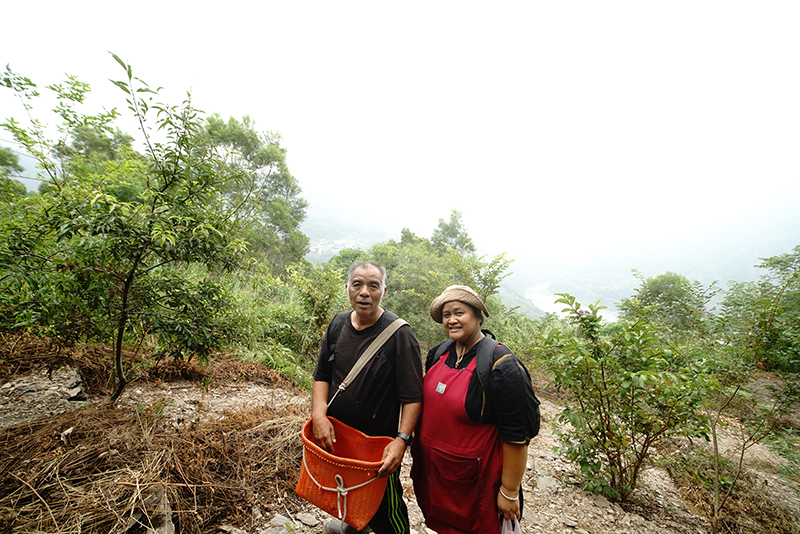
Thirty Years into Tree Planting
to Restore Ancestors’ Forests
Since the 1990s, Sula has begun his great cause of planting trees with the support of his parents. Saddened by the sight of their ancestral forests being depleted by loggers and the government, the destruction of wildlife habitats, and the central reforestation policy that focuses on a single exotic species, the family decided to restore forests on their own without seeking any government funding. They used their money to purchase land, nurture seedlings, and persuade landowners to transfer their abandoned farmland for cultivating native trees. Over the years, with a constant effort, they have completed their First Planting Area, which lies at altitudes of 500 to 1,200 meters above sea level with an area of 100 hectares or so. When the planting comes to an end, they return the forest to nature and never enter the land again.
Dresedrese joined their ranks after marrying Sula in 2003. As Sula’s parents grow older, the couple takes over the family business, regarding tree planting as their lifelong mission.
The planting of trees follows a routine annually from October through the rainy season of the following year. To begin with, Sula would have to spend several months clearing the land of “weeds:” invasive foreign species such as Malabar chestnut (Pachira aquatica) and bittervine (Mikania micrantha), which are highly productive and fast-growing. The former, in particular, used to be promoted by the government as one of the incentive species in its reforestation programs because of its economic value as a landscape tree. Yet it has proved problematic thanks to its invasiveness that tends to squeeze out other native trees, which has damaged the biodiversity of Taiwan’s mountain forests.
“These foreign species grow and spread rapidly after being introduced, becoming a lethal threat to native trees. Without trees, there is no food for the wildlife and hence no prey for hunters. Planting trees is not that difficult; the most tiring task, however, is to weed. That is, to clear these harmful species of the land,” says Dresedrese.
One doesn’t need to learn from textbooks or experts to know such things as how to restore mixed forests, what to plant in what season, how far apart should different trees be planted, and how to prune excessive foliage to slow down evaporation of water from trees. “Nature will teach us how to do that,” adds Sula. The various knowledge for planting trees has long become internalized as an intuitive part of their lives through the accumulation of experience for years.
At the Third Planting Area, Sula climbs up the slope and begins to dig holes for Dresedrese to plant seedlings. Then she backfills and compacts these holes with soil just loosened. As she waters the trees, she gives a silent blessing in Rukai, wishing each of them” grow up healthy with so many companions being around.”
The Sukinadrimi family has been devoted to tree planting for two generations over a time span of nearly 30 years, a cause that takes much time but yields no real economic benefits. Their aim is simply to protect the land and forests and conserve wild plants and animals that inhabit there. Sula admits that he did think about giving up when he was young. But as he recalled the feelings he felt in the mountains with his father as a child, he soon regained his motivation. “When I see a tree that grows as tall as a house, I realize this is where my value lies.”
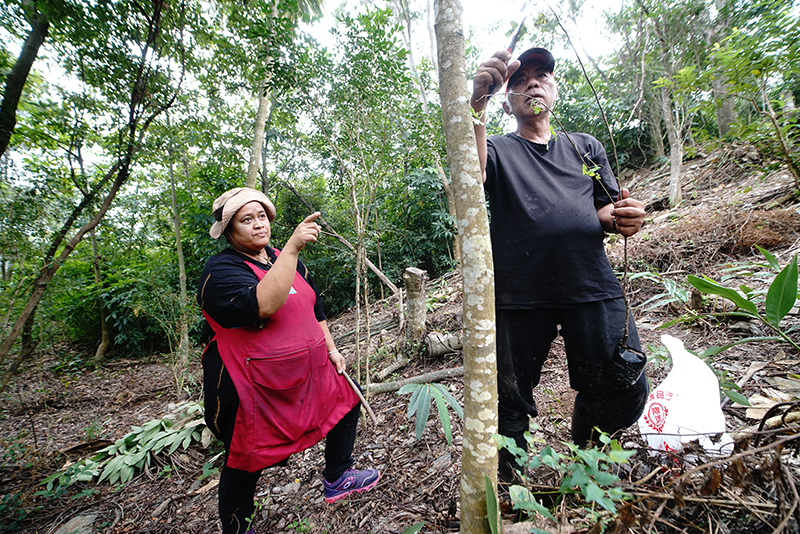
Finding Herself
Back in the Mountains
When it comes to how one may find their self-worth in the process of planting trees, Dresedrese, who has returned home from the city, is particularly impressed.
Born into a Rukai clan that hails from the Kucapungane Community in Pingtung County, Dresedrese is raised in the city because her family has moved away since her grandfather’s time. Only on holidays would they come back to the relocated community. Therefore, although she’s been aware of her Rukai identity since her childhood and understands the language, Dresedrese never has a genuine understanding of her mother culture. “I know I am Rukai and a descendant of the community leader; my grandmother was the matriarch of the clan, and I can get fully dressed in an ornate costume with an eagle feather headdress for rituals. But I still do not know what it means to be ‘Rukai,’” says Dresedrese.
Dresedrese became increasingly doubtful about her identity as she grew older. After going out into society and began to work, she felt an ever-growing sense of cultural loss, which made her feel very frustrated. It was this sense of powerlessness and emptiness that drove her “back to the mountains.”
She chooses to settle down at the Kabalelradhane Community, where her stepfather and families on her mother’s side reside, and runs a drinks stand and breakfast restaurant for a living. In her spare time, Dresedrese likes to pester the community elders to chat with her, and she would document their stories using a camera and a digital recorder to learn more about her roots.
Shortly afterward, she met Sula and fell in love with him. “He is a man with a unique mind,” says Dresedrese, attracted by his concerns for the land, forests, and the culture of his people. After they get married, she becomes the bread earner in the family. What’s more, she even helps them purchase the land for the Second Planting Area by putting up her family’s properties as collateral for a loan. “Anyway, I am still running a breakfast restaurant. At least it ensures we can make ends meet, and that’s enough.” Dresedrese says with a laugh.
Dresedrese relates her resolution as if it were nothing impressive. Yet back when she decided to marry Sula, her family did ask her to consider it carefully, questioning “Are you sure you want to move back to the mountains? The family you will marry into, what they do is simply plant trees. That means you’ll not only have to help them with planting trees, but also feed the whole family. Think again before you do!”
Eighteen years have passed since she became Sula’s wife and a tree planter. Asked if she ever regrets it, Dresedrese answers with a look of clear-sighted determination,” Over these years, I’ve been seeking to discover ‘who I am’ and ‘where I come from.’ It is not until I married my husband and came to understand his family’s cause, have I finally found the answers to these questions.”
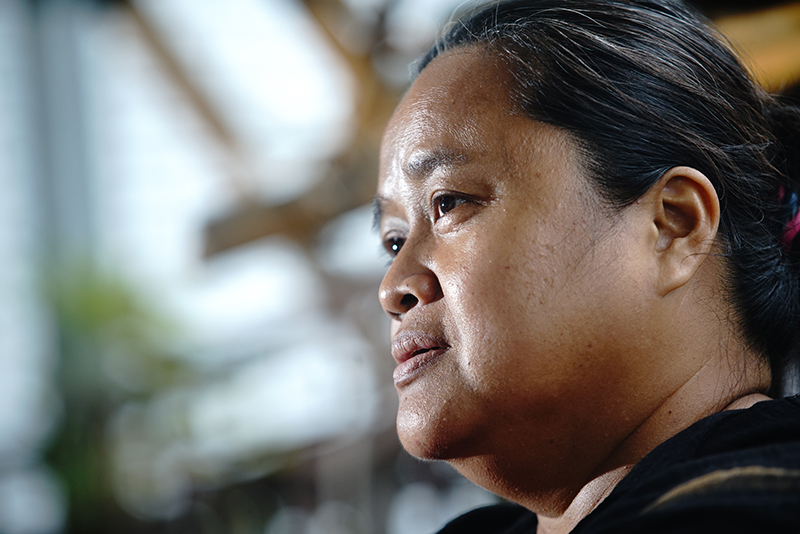
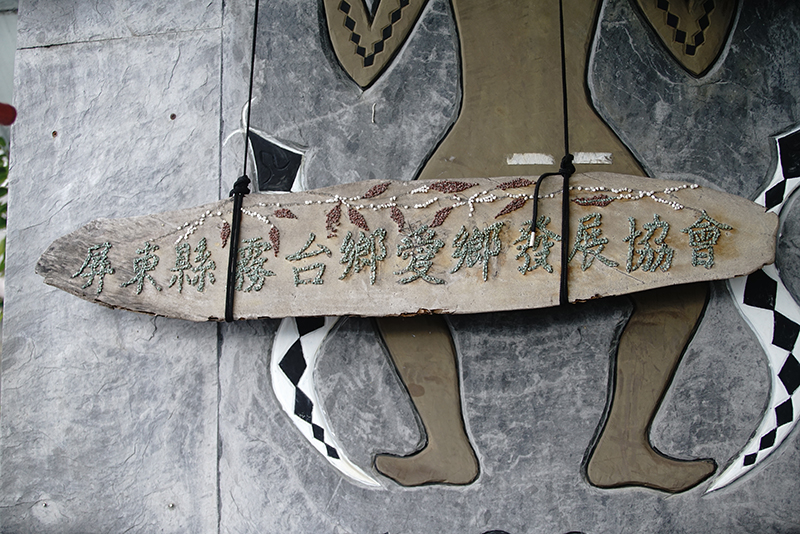
Paving a Way Home for Compatriots
by Developing Eco-tourism
Sula Sukinadrimi himself also understands that judged by the standards of modern society, he is unqualified as a husband for failing to take up the responsibility to raise his family. “Every day at the sight of her getting up in the early hours of the morning, I’d think to myself, ‘Ah, it’s just another day for a kept man,’” says Sula self-mockingly as he looks at Dresedrese with guilt.
“I take it as our ‘career.’ While making money is important for sure, planting trees for the future generation is no less urgent. As long as we work at a steady pace and do as much as we can, one day we’ll see our efforts pay off,” Dresedrese responds softly, “If tree planting can bring in regular income for the community, it will encourage more community members to return or stay, and create an opportunity for us to develop eco-tourism as a source of economy.”
Dresedrese believes that as long as there are job opportunities in the community, with people staying, the language and culture will naturally be passed on. This in turn allows their future generations to be nurtured in their homeland and acquire the mother tongue, without having to go through the same process of self-identification as their parents do. This process is just like nurturing the seedlings for transplantation. Those young trees, while not as tall and big as old ones, are deeply rooted in the soil where they are planted and are therefore able to hold on to the land to withstand storms and protect the earth.
